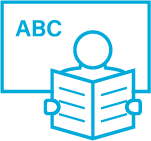Associations Between Reading Skills, Interest in Reading, and Teaching Practices in First Grade
This study examined associations between classroom-level reading fluency, comprehension, interest in reading, and teaching practices. In classrooms with mostly child-centred methods, children showed better reading fluency, comprehension, and higher interest, whereas in classrooms with predominantly teacher-directed practices, children had lower reading comprehension at the end of grade 1.
Authors: Eve Kikas, Eija Pakarinen, Piret Soodla, Kätlin Peets & Marja-Kristiina Lerkkanen
Source: Kikas, E., Pakarinen, E., Soodla, P., Peets, K. & Lerkkanen, M.-K. (2018). Associations between reading skills, interest in reading, and teaching practices in first grade. Scandinavian Journal of Educational Research, 62(6), 832-849. DOI: 10.1080/00313831.2017.1307272
This study examined associations between classroom-level reading fluency, comprehension, interest in reading, and teaching practices. Participants were 466 children from 21 classrooms. Teachers were more likely to use teacher-directed methods in classrooms where children had poorer initial reading fluency. In classrooms with mostly child-centred methods, children showed better reading fluency, comprehension, and higher interest, whereas in classrooms with predominantly teacher-directed practices, children had lower reading comprehension at the end of grade 1.
- It is widely accepted that teaching practices influence children’s learning and development.
- Numerous studies show the positive effects of child-centred (learner-centred) teaching practices on children’s academic skills and motivation; however, some studies have found beneficial effects from teacher-directed practices on the development of basic academic skills.
- Teachers do not uniquely influence children’s academic and motivational development, but children also affect the practices teachers use.
Child-centred and teacher-directed teaching practices
- Child-centred and teacher-directed practices differ in the degree to which teachers allow children to actively construct their knowledge (vs. teach basic skills), include children in various discipline-related decision processes (vs. set the rules), and engage in creating a positive social climate via individual support.
- While teacher-directed practices value frequent feedback on academic tasks, child-centred practices emphasize the importance of emotional support and encouragement.
- There are benefits of child-centred practices across the academic, motivational, and social domains of functioning at the individual as well as the classroom level.
- There is also evidence that teacher-directed practices can be beneficial in kindergarten and primary school, and/or for students with poorer academic skills when learning basic academic skills such as letter knowledge, decoding, and numeracy skills.
- However, there is evidence that teacher-directed practices may hinder motivation, including interest.
The influence of student characteristics on teaching practices
- Teachers are continuously required to make decisions about their instruction, classroom management, and support while considering the needs of students and the aims of teaching.
- For instance, Vygotsky (1978) emphasized that the most effective learning takes place in the zone of proximal development (ZPD); thus, teachers should modify their methods and tasks to correspond to children’s skill levels.
- Not only individual, but also collective student characteristics can influence the kinds of practices teachers use.
- However, which practices teachers use with individual children vs. the whole classroom may differ depending on teachers’ knowledge and beliefs.
The study
The aim of the present study was to examine associations between classroom-level reading fluency, comprehension, and interest in reading and teaching practices in first-grade classrooms.
Research questions:
- Do classroom-level initial reading fluency and interest predict child-centred teaching practices, and do these practices in turn predict children’s reading skills and interest at the end of the school year?
- Do classroom-level initial reading fluency and interest affect teacher-directed teaching practices, and do these practices affect children’s reading fluency, text comprehension, and interest at the end of the first school year?
The participants were 466 children (233 girls and 233 boys) from 21 first-grade classrooms from seven public schools with Estonian as the principal language. In Estonia, children usually attend schools based on proximity. All 21 first-grade teachers were female.
Findings
- The results showed that the more child-centred teaching practice teachers used, the better the children’s reading fluency and comprehension skills at the end of first grade were.
- Initial reading fluency and interest in reading typical of the classroom did not predict child-centred teaching practices.
- The higher the parental educational level was, the better the reading fluency the children showed in that classroom when entering school.
- Teacher experience or class size did not predict teaching practices or reading skills.
- At the individual level, the higher the parental educational level, the higher the child’s level of reading fluency and reading comprehension were at the end of first grade.
- Girls showed higher interest in reading and better reading fluency at the beginning of the school year, as well as better reading comprehension at the end of first grade.
- The more child-centred teaching practice a teacher employed, the more interest in reading the children reported in that classroom at the end of the school year.
- Teacher experience, class size, and parental educational level did not predict children’s interest in reading or teaching practices.
- Teachers were found to provide more teacher-directed practices in classrooms where children scored lower on initial reading fluency.
- Teacher-directed practices were negatively associated with children’s reading comprehension, but not with reading fluency at the end of grade 1 after controlling for children’s previous reading fluency and interest in reading.
- Children’s initial reading fluency was negatively associated with teacher-directed practices.
- Teacher-directed teaching practices were not significantly related to children’s interest in reading.
- Interest in reading at the end of the first grade was predicted by initial interest in reading, gender, and family education, indicating that interest in reading showed moderate stability and was significantly higher at the end of the first school year among girls and children from highly educated families.
Conclusions
- The results showed that child-centred practices were related to higher reading skills and interest in reading at the end of grade 1.
- An effect was found for collective student characteristics on teacher-directed practices: in classrooms where children had poorer initial reading fluency, teachers relied more frequently on teacher-directed practices.
- Teacher-directed practices were in turn related to poorer reading comprehension at the end of grade 1.
- Child-centred teaching practices were associated with children’s better reading skills and interest in reading at the end of first grade, even after controlling for the initial levels of children’s reading fluency and interest.
- Thus, in classrooms where teachers generally encourage children’s active construction of knowledge, emphasize the discussions about rules and activities, and provide emotional support, children’s specific skills such as reading fluency and comprehension improve.
- It is possible that teachers who use child-centred methods expose children more frequently to varied types of texts and give children more possibilities to choose what to read, but also discuss the reading material and thereby promote children’s interest in reading.
- Teachers may prefer teacher-directed methods with children who have poorer academic skills because they believe in the effectiveness of such practices and it may make it easier for them to manage classroom situations.
- However, no beneficial effect of teacher-directed practices on reading fluency was found, and teacher-directed methods were related to lower-level reading comprehension at the end of first school year.
- Teachers should be encouraged to rely on child-centred teaching practices in the beginning of school when trying in improve children’s reading skills and interest in reading.
- This study also informs us about the negative effects of teacher-directed practices on reading comprehension and interest.
- These practices do not satisfy children’s basic needs for belongingness and autonomy, and instead seem to be inhibiting the development of more complicated skills like reading comprehension.
- Teachers should try to create classroom environments where children feel that their teachers are supportive and encouraging and that they are regarded as active participants in the teaching process.
- It is important for educators to make sure that young teachers are provided with a set of practical skills to best nurture children’s academic, motivational, and emotional needs and that they are not left alone when challenges arise in the classroom.



